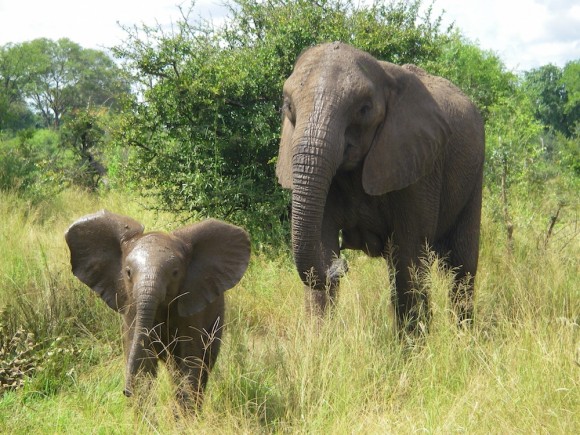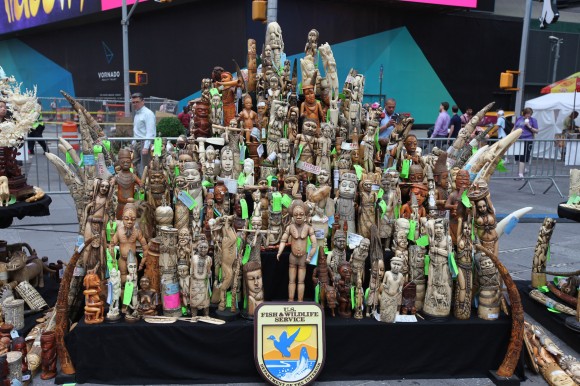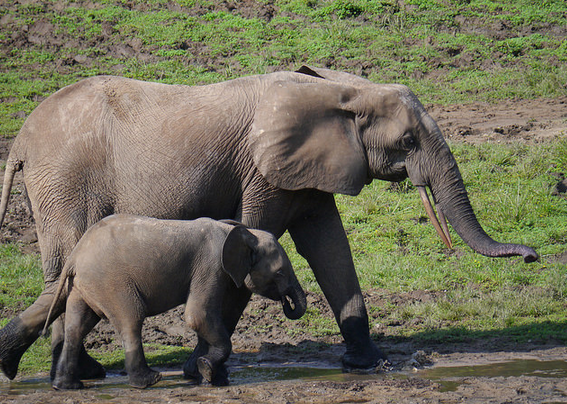 aNewDomain — On Saturday President Obama announced new regulations to protect endangered African elephants by restricting the ivory market in the US. The announcement arrived from Kenya, where US President Barack Obama was attending the Global Entrepreneurship Conference.
aNewDomain — On Saturday President Obama announced new regulations to protect endangered African elephants by restricting the ivory market in the US. The announcement arrived from Kenya, where US President Barack Obama was attending the Global Entrepreneurship Conference.
I wanted to know whether Obama’s new ivory restrictions are really going to be enough to slow or stop the wholesale massacre of the already decimated African elephant population, so I dug in and spoke to insiders. Here’s my report.
First some background: More than 100,000 African elephants were slaughtered by poachers for their tusks just from 2010 to 2012 alone.
The US is a significant marketplace for ivory. These new restrictions, if finalized in September, will create an almost a total ban on domestic sales, import and export of African ivory.
The proposed regulations complement the National Strategy For Combating Wildlife Trafficking, published by the White House in Feb. 2014.
These restrictions are a long time coming, no question. The ivory trade has decimated the African Elephant population, even though trade in ivory has slowed since its heyday in the 1950s and 1960s.
And consider: There were 1.2 million African elephants li ving in 1980. But by 2012 there were only 480,000 of them left.
ving in 1980. But by 2012 there were only 480,000 of them left.
Where does illegal ivory go and who buys it?
This is a key question. According to reports from the NRDC, a lot of it reportedly winds up in East Asia, and also black markets in the US and elsewhere. Buyers often carve into jewelry, chopsticks, bookmarks and other trinkets.
This seems like a far cry from the giant ivory ornaments that the newly wealthy used to buy legally in the US as two to six-foot ivory “elephant tusk sculptures” once so trendy in the US. Yes, the ivory come in smaller packages these days. But it is still causing the senseless slaughter of African elephants.
Hundreds of thousands or even millions of trinkets take more ivory then a few expensive big sculptures, experts have increasingly pointed out over the years.
Every day 96 elephants are killed, the NRDC report says. And then there’s this:
Every 15 minutes an elephant dies at the hands of poachers.

I spoke with Elly Pepper, a wildlife advocate for the Natural Resources Defense Council about how these new regulations can help protect elephants.
I asked what individuals can do to help save endangered elephants in Africa — and Asia, too.
Regulations are an important step, Pepper said. But they still need strengthening, even with the proposed new ivory restrictions from Obama.
For example, the proposed rule exempts antique ivory.
The problem with this is that recently poached ivory can be treated with tea and other substances to appear older. U.S. Fish & Wildlife and state officials lack the resources to do expensive tests to determine if “antique” ivory is authentic or not on every item.

“The U.S. is a significant market for elephant ivory, and NRDC just commissioned a report a couple of months ago regarding Elephant Ivory Trafficking in California. They found 1,250 ivory items for sale by 107 vendors in the state. People sell ivory in many different ways ranging from the Internet to brick and mortar stores. In San Francisco’s Chinatown, you can find ivory displayed in store front windows,” Pepper said.
The NRDC helped get ivory restriction legislation passed in New York last year. Pepper hopes the NRDC can help California pass AB 96 this year. The bill, which was passed by the State Assembly in June, would close loopholes in California’s current law, for instance. That laww now bans sales of ivory that was imported prior to 1977.
AB 96 is currently in the Senate Appropriations Committee suspense file because it will cost money to implement. Pepper hopes the bill will come before the Senate in September.
Ivory regulations can be strengthened by removing the exemption for antique ivory and further restricting trophy hunting, Pepper said.
Gavin Shire, a spokesman for the U.S. Fish & Wildlife Service (FWS) said that the antique ivory exemption is actually part of the Endangered Species Act, and recent Executive Orders, including Director’s Order 210, have put the onus on the owner to prove the ivory is antique.
Director’s Order 210 puts the burden on the importer, exporter, or seller to prove their ivory is antique and not new ivory that has been dyed with tea or other substances to appear antique.
FWS has held ivory crushes in New York and Denver to destroy seized ivory and increase public awareness about poaching. Check out this video of the NYC Ivory Crush, below.
“We are trying to make people aware of the scale of the problem and what it means to elephants in the wild. When you are on vacation and have the opportunity to buy a piece of ivory, there’s no way to know the source or age of that ivory, despite guarantees you may be given that it’s old. New ivory is often dyed or artificially aged to make it look old. The demand for ivory is what is causing the poaching that is decimating elephant populations across Africa,” Shire told me.
What if you own illegal ivory? Should you do something about it?
I told Pepper and Shire that I have a necklace that my uncle gave to me as a kid in the 1970s.
He traveled a lot. And I never wear it. I don’t wear it because I worry that it might be a product from poaching.
Pepper and Shire both told me that I’m not alone: Many people realize they may have illegal ivory in their possession and aren’t sure what to do about it. Shire said that in the recent past, poaching wasn’t a major threat to elephant populations.
Shire said that in the 1970s, poaching wasn’t a major threat.
“From the 80s on, poaching has become the purview of organized criminals and cartels with supply routes across nations and across oceans,” said Shire.
“It’s that scale of poaching that is causing havoc to elephant populations.”

How to take a stand.
Still wondering what you can do? Here are four actions you can take to help elephants right now:
- Don’t buy ivory, and take the 96 Elephants pledge not to buy or sell ivory.
- If you live in California lobby lawmakers to ban the sale of ivory.
- Write to President Obama and ask that he narrow the proposed ivory rules. Offer reasons why during the public comment period, which ends on September 28. Include a sentence like: I am an American who is deeply troubled by the exemptions granted in Part 17.2 (9) re: antique ivory.
- Buy a Tiger stamp aka Save Vanishing Species Stamp and benefit conservation funds.

What travelers can do:
- No matter where you visit in Africa or China, don’t buy ivory or any wildlife parts or products.
- Visit Africa and go on a wildlife safari. Help create jobs so that travelers give poachers a better way to earn money.
- If going on a safari in Africa, try to use a company that has a record for giving money to conservation. A Safari guide company doesn’t have to own the wildlife sanctuary to invest tourism dollars in stopping poachers and saving endangered elephants.
- When choosing a safari company, choose one that hires local people so they don’t wind up hired to do the poaching.
- Take photos of elephants and share them with the world and encourage people to love elephants, not ivory.
The idea is to kill the ivory market, not the elephants …

If we reduce the U.S. demand for ivory, other nations will follow suit. Hopefully.
And when we are able to take the current ivory demand down to a minimal level — a few grams of ivory here and there for violin bows or piano keys — another elephant’s life is saved.
I admit I find ivory beautiful. But that’s when it’s the ivory elephants wear themselves.
For aNewDomain, I’m Terry Gardner.
Credits:
Every photo and video in this piece comes with All Rights Reserved.
Photo of New Yorkers supporting Elephants at NYC Ivory Crush 2015: Kelsey Williams/FWS, All Rights Reserved.
African elephants in Dzanga Sangha, Central African Republic: Daphne Carlson Bremer/USFWS
All photos that came courtesy of NYC Ivory Crush 2015: Kelsey Williams/FWS. All Rights Reserved.













